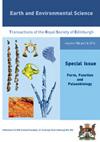Characterising the cave bear Ursus spelaeus Rosenmüller by ZooMS: a review of peptide mass fingerprinting markers
IF 1.2
4区 地球科学
Q4 GEOSCIENCES, MULTIDISCIPLINARY
Earth and Environmental Science Transactions of the Royal Society of Edinburgh
Pub Date : 2023-02-27
DOI:10.1017/s1755691023000038
引用次数: 1
Abstract
In the last decade, the identification of bone fragments by peptide mass fingerprinting or zooarchaeology by mass spectrometry is developing as a powerful tool in Quaternary palaeontology. The sequence of amino acids that make up the bone collagen molecule shows slight variations between taxa, which can be studied by mass spectrometry for taxonomic purposes. This requires reference databases that allow peptide identification. Although the cave bear (Ursus spelaeus Rosenmüller, 1794) is a common component in many European Pleistocene cave sites, no peptide fingerprint taxonomic study has paid special attention to this species up to now. For peptide markers in Ursidae, the most recent proposal is based on collagen obtained from a modern brown bear sample. In this work we attempt to cover this gap by studying bone collagen of cave and brown bear samples from different origins and different chronology, applying matrix-assisted laser desorption/ionisation time-of-flight mass spectrometry (MALDI TOF). We also performed an in-silico study of ursid bone collagen sequences published in databases. In our results we detected some discrepancies between the peptides obtained from both in silico and MALDI TOF analysis of fossil collagen and those published in the literature, in which we conclude that there are some misidentified peptides. The identification of skeletal remains by means of their peptide fingerprint is proving to be a powerful tool in palaeontology, which will bear greater fruit once the limitations of a technique that is in its initial stages have been overcome.用zoom表征洞熊Ursus spelaeus rosenmller:肽质量指纹标记的综述
在过去的十年里,通过肽质谱指纹或通过质谱进行动物考古来鉴定骨骼碎片正在成为第四纪古生物学的有力工具。组成骨胶原分子的氨基酸序列在分类群之间显示出轻微的差异,可以通过质谱法进行分类研究。这需要允许肽鉴定的参考数据库。尽管洞穴熊(Ursus spelaeus Rosenmüller,1794)是许多欧洲更新世洞穴遗址中的常见组成部分,但迄今为止,还没有肽指纹分类学研究对该物种给予特别关注。关于熊科的肽标记物,最近的提议是基于从现代棕熊样本中获得的胶原蛋白。在这项工作中,我们试图通过应用基质辅助激光解吸/电离飞行时间质谱(MALDI TOF)研究来自不同来源和不同年代的洞穴和棕熊样品的骨胶原蛋白来弥补这一空白。我们还对数据库中发表的ursid骨胶原序列进行了计算机研究。在我们的结果中,我们检测到从化石胶原蛋白的计算机和MALDI TOF分析中获得的肽与文献中发表的肽之间存在一些差异,其中我们得出结论,存在一些错误识别的肽。通过肽指纹识别骨骼遗骸被证明是古生物学中的一个强大工具,一旦一项处于初始阶段的技术的局限性得到克服,这项技术将取得更大的成果。
本文章由计算机程序翻译,如有差异,请以英文原文为准。
求助全文
约1分钟内获得全文
求助全文
来源期刊
CiteScore
2.00
自引率
0.00%
发文量
21
期刊介绍:
Earth and Environmental Science Transactions (formerly Transactions of the Royal Society of Edinburgh: Earth Sciences) is a general earth sciences journal publishing a comprehensive selection of substantial peer-reviewed research papers, reviews and short communications of international standard across the broad spectrum of the Earth and its surface environments. The journal prides itself on the quality of its graphics and photographic reproduction. The Editors are keen to encourage interdisciplinary papers and Transactions also publishes occasional special symposia and invited volumes of specific interest.
We are currently in the process of digitising the archive of RSE Publications, and the archive of the Transactions, dating back to 1788, will be available from the back issues link on this site.

 求助内容:
求助内容: 应助结果提醒方式:
应助结果提醒方式:


